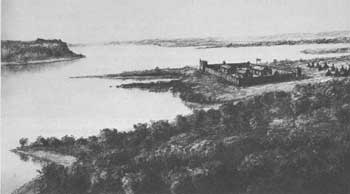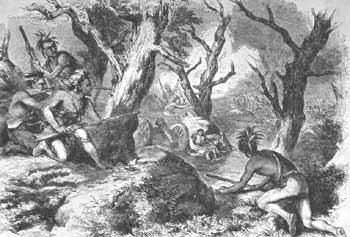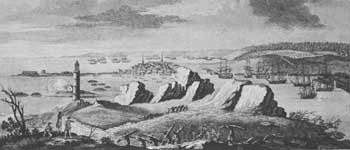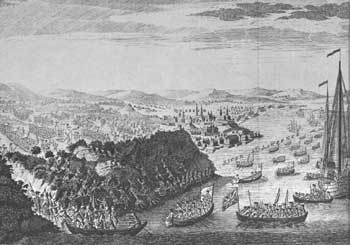






Historical Background
The French: Trappers and Traders (continued)
TWILIGHT OF EMPIRE
French energies in North America were soon diverted from exploration and settlement to defense against the expanding English. As early as 1613, England had reacted to the French threat in North America by sending an expedition from Virginia under Capt. Samuel Argall to wipe out the feeble French colony at Port Royal, which had been reestablished in 1610 following the failure and abandonment of the first colony there 2 years earlier. In 1629, the English occupied Quebec itself for a short time.
When the French quelled the Iroquois in 1666, they may have had a moment of opportunity to dominate the English by moving into the Hudson Valley and New England. But they vacillated too long. England seized the initiative by capturing the Dutch settlements on the Hudson River and taking over the Iroquois fur trade, which the Dutch had found so profitable.
Three European wars between England and France were reflected in minor struggles between their colonies: King William's War (1689-97); Queen Anne's War (1702-13); and King George's War (1745-48). Because in all of these wars French colonists suffered losses to their British counterparts, in the period of peace after 1748 France determined to so strengthen her hold on the Mississippi Valley that England could not shake it. In 1749, she dispatched Celoron de Blainville from Montreal into the Ohio Valley, occupied by Indians and English traders, to affirm French claims to the region. The principal result of his trip was increased hostility on the part of the pro-English Indians.
 |
| Fort Beauharnois, a French post and site of a Jesuit mission, erected in 1727 on the west bank of the Mississippi River, in present Minnesota. From a charcoal drawing by Fletcher Sultzer. (Courtesy, Goodhue County Historical Society, Minnesota.) |
In the period 1750 to 1755, the French augmented the fortifications at old Fort Niagara as well as those at Fort St. Frederic, which in 1731 had been built on Lake Champlain. Also, in 1753, they rebuilt Fort de Chartres. New posts included Fort St. John (1748), on the Richelieu River north of Lake Champlain; Fort de la Presentation (1749), north east of Lake Ontario; Fort Rouille (1749), on the western shore of Lake Ontario; Fort Presque Isle (1753), east of Lake Erie in present western Pennsylvania; Fort Le Boeuf (1753), also in western Pennsylvania; and, of primary importance, Fort Duquesne (1754), at the Forks of the Ohio.
Thus by the mid-18th century the final conflict, long deferred by the unwillingness of either side to make an all-out effort, was at hand. Englishmen were spilling over the Appalachians into the Ohio Valley, erecting trading posts and blazing trails into the heartland claimed by France.
It was the construction of Forts Le Boeuf and Duquesne that provoked the French and Indian War and brought disaster to the French in North America. Shortly after they built Le Boeuf, a small contingent of troops from its garrison seized and occupied Venango, an English trading post. Maj. George Washington, only 21 years of age, was dispatched from Virginia in the winter of 1753-54 to protest the action. His remonstrations were in vain, both at Venango and Le Boeuf, although he was courteously treated despite his youth.
 |
| Artist's rendition of the Battle of Monongahela, in 1755, one of the bloodiest in the French and Indian War and a major French victory. A group of Frenchmen and their Indian allies are shown here ambushing Gen. Edward Braddock's troops. From a wood engraving by John Andrew, after Billings, published in 1858. (Courtesy, Library of Congress.) |
To counter the rebuff, English officials in Virginia decided to drive the French out. In March 1754, Washington and 300 Virginia militia set out across the mountains to construct a defensive post at the strategically located Forks of the Ohio. A month earlier Capt. William Trent and about 30 men had proceeded to the site. Unknown to Washington, they had been captured by an overwhelming force of French and Indian allies, who constructed Fort Duquesne as their own defensive outpost against the English. While Washington advanced steadily but slowly through the mountains, French scouts carefully watched his progress. On May 28, the first skirmish occurred.
Learning from prisoners of the strong force ensconced at Fort Du quesne, Washington attempted to provide a defense for his troops from the certain French attack. At Great Meadows he and his men hastily threw up a log palisade they called "Fort Necessity." On July 3,1754, more than 600 French and Indians, skilled at forest combat and attacking from natural forest cover, invested the little fort. After 9 hours of heavy fighting, Washington surrendered, but he was allowed to march from the post with the "honors of war," on a date that was to prove portentous—July 4.
 |
| Louisbourg, on Cape Breton Island, Canada, in 1758, besieged by British Gen. James Wolfe. It was a major French base during the French and Indian War. From an engraving by P. Canot, after an on-the-scene drawing by Captain Ince of the 35th Regiment. (Courtesy, Library of Congress.) |
The martial conflagration thus ignited soon spread to most of the nations of Europe and about 100 colonial posts around the globe. The next year, the French troops successfully defended Fort Niagara and routed the proud British force under Gen. Edward Braddock that at tempted to conquer Fort Duquesne. In 1756, the war, so far confined to the New World, broadened to Europe. The following year, when the British were still off balance, the French brought in fresh European troops and captured post after post along the English frontier. But in 1758 the tide of fortune turned. When Quebec fell to the British in September 1759,the war in America was over to all intents and purposes—even though hostilities continued for another year. In the spring of 1760, the French besieged Quebec; and, late in the summer, the British surrounded Montreal. Finally, in September, the Governor of Canada surrendered the whole of Canada to England.
As the defeat of France elsewhere in the world became assured, in 1762 she hastily consigned western Louisiana to her ally Spain by the secret Treaty of Fontainebleau Then, in the Treaty of Paris the following year, she surrendered the rest of her North American possessions to Great Britain. Spain had to relinquish Florida in return for the restoration of her key posts of Havana and Manila, which had fallen to the British Navy. The French Empire in the New World was no more—although for a few weeks in 1803 France repossessed Louisiana from Spain, but almost immediately transferred it to the United States.
 |
| "A View of the Taking of Quebeck by the English Forces Commanded by Gen. Wolfe," in 1759. Soon after Quebec capitulated, the French and Indian War ended and Canada came under British rule. From an engraving by an unknown artist, published in 1760. (Courtesy, Library of Congress.) |
 |
 |
http://www.cr.nps.gov/history/online_books/explorers-settlers/intro16.htm
Last Updated: 22-Mar-2005